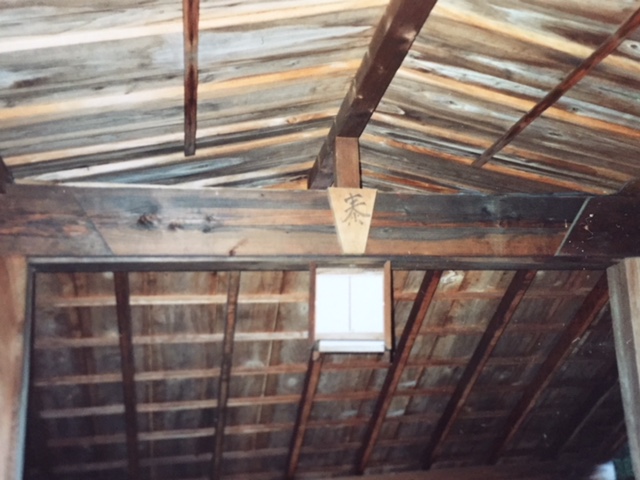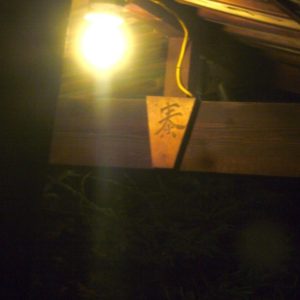The Mysterious Symbol
August 8, 2014
Late at night, my first winter in the Japanese house, I was sleeping on cushions on the floor when my resident herd of deer ran through the front courtyard, and set off the motion detector light at the upper entrance, flooding the interior with light. Wearily, I crawled out of my improvised “bed.” While trying to figure out how to turn off the light, I suddenly saw through the window – attached just beneath the eave of the porch roof – a mysterious, hand-lettered Japanese symbol, that had been painted onto a fan-shaped bit of wood! I realized at once that the symbol could only be seen from where I was standing, inside the house, and only with a floodlight illuminating it, as now! In daylight, standing right beneath it, the symbol would be nearly invisible. So before the clock timer could switch the outside light off, I grabbed my pocket digital camera and snapped an image of the hidden symbol.
I have dozens of books people have sent me ever since I began this quest to restore the house: books about Japanese art, architecture, culture, flower arranging, symbols, ceremonies, gardens – even the uses of bamboo. I looked up this symbol in my book Japanese Detail Architecture by Sadao Hibi (Chronicle Books 1987) and I thereby learned that there is a tradition of this type of symbol, located on a building where we, in the West, would place the keystone of an arch (an esoterically significant spot, as any freemason will tell you.) In Japanese it is called a Kaerumata, meaning something like “frog’s crotch” for its pelvic shape, and was actually first used as a keystone but now is a lucky, and often highly decorative ornament, sometimes sporting dragons in jade or flying cranes in mother-of-pearl. I resolved to delve further into the mystery!
Research at Smithsonian Libraries
Some years ago, I became the first author ever invited onto the Board of the Smithsonian Libraries here in Washington, DC. These twenty libraries are a fabulous repository of knowledge and books, all of it owned by – and available to – all our fellow Americans. My own specialty happens to be in taking advantage of other people’s wisdom (especially if it’s free!) And so, immediately after I found the symbol, I sent a copy of my photo to our chief librarian, Reiko Yoshimura, at the Smithsonian Freer/Sackler Gallery of Asian Art:
Dear Reiko: I was sleeping at my Japanese House last night and the deer herd passed by and set off the front porch motion detector light. When I got up to turn it off, I saw (for the first time) that Mr Teruo Hara had put a hidden plaque just under the roof (which is about to collapse.) And I’d like to know what it says. Also we would like some serious reference materials on the history and use of the Kaerumata in early Japan.
Can someone translate for me?
Best– Katherine
Reiko’s reply:
Dear Katherine,
This is a character, “泰”, pronounced as “TAI.” It means: broad, comfortable, stable, peaceful. I am not sure the intention, but the architect might have made a wish to the new house, which is not uncommon in Japan. Sometimes they paste a charm from shrines so that Shinto gods would protect houses from natural disasters, etc.
Originally this character looked like the one below. The top part is a human standing, the second, two hands with arms draping on both sides, and a character “water” between the arms. Together, it describes “two hands supporting a human (stable) above the water (unstable)” which represents security and reassurance.
Kaerumata (which means “frogs’ legs”) was used as early as the Nara period (710-794) and by the Edo period (1600-1868) it had become highly elaborated and decorative.

Research in the field
Tai also describes, according to other masters in the field, the Japanese name for Thailand, for an ocean fish, for a baby panda at the Washington DC zoo, the martial arts form Tai Chi, and according to a Japanese expert who appeared on my doorstep only this morning: Tai means “Superior or Great!”
If this house is the House of Tai, then let us explore the other house that Teruo Hara built on Martha’s Vineyard: Chogetsu!

